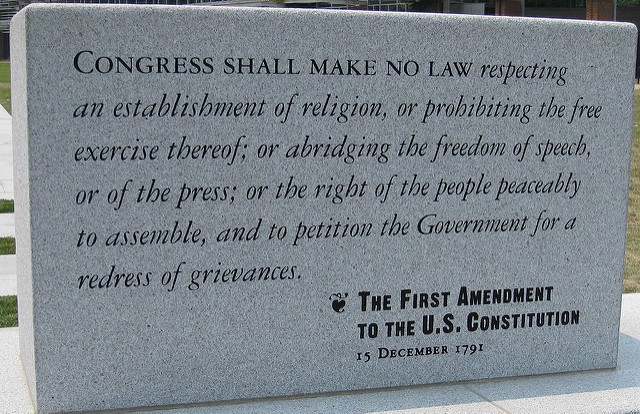‘Student Press Freedom Day’ reminds Arizonans that high school journalists need First Amendment protections now
First Amendment to the U.S. Constitution, Independence Park, Philadelphia
January 30, 2019
OPINION
The First Amendment rights and freedom of the press is a bedrock tenet of journalism and for high school journalists— and yet, in Arizona, school administrators are using the 1988 Hazelwood School District v. Kuhlmeier ruling from the Supreme Court more and more as justification to censor journalistic content from student publications that they don’t like or that they find objectionable.
Public colleges and universities, according to the Student Press Law Center, are among those institutions where the “First Amendment drastically limits the school’s ability to censor. Among the censoring actions the courts have prohibited are: confiscating copies of publications, requiring prior review, removing objectionable material, limiting circulation, suspending editors and withdrawing or reducing financial support.”
But these protections are not necessarily in place for Arizona high schools and other high schools across the nation.
The Hazelwood ruling—to date, has done more to curtail the rights of high school student voices across America—and it is time to change this practice.
Arizona high school student journalists and indeed, the students they serve, need to know that even though Hazelwood has given school administrators greater authority to censor some school sponsored student publications—the ruling requires school officials to demonstrate some reasonable educational justification before they can censor.
High school student publications need to push back against censorship on high school campuses by demanding that school officials clearly show these “reasonable educational justifications” of censorship and take action against the practice.
Jan. 30 is Student Press Freedom Day and high school student journalism will be supported by college and university journalists as well as professional journalists, broadcasters and reporters across the nation, in order to voice concern and bring awareness to the growing trend of high school student press censorship.
On May 24, 2017 Arizona’s governor, Doug Ducey vetoed a bi-partisan “New Voices” bill—Senate Bill 1384—introduced by Republican Senator Kimberly Yee that would have placed limits on the ability of school officials to censor what student journalists write.
Ducey vetoed the bill—a measure to protect the student press and the First Amendment in Arizona and a bill that essentially had no measurable dissent and secured 41 votes in the 60-member House.
This bill would have included Arizona as one of the fourteen states that have adopted measures to protect a free and open student press in Arizona for high school news publications, instead, Ducey essentially removed First Amendment rights from student journalists, handed over authority to pick and choose written content and placed it squarely in the lap of administrators and school officials.
In a 2017 article Ducey responded to criticism over his veto of SB 1384 and said in a released statement.
“This bill could create unintended consequences, especially on high school campuses where adult supervision and mentoring is most important.”
Former Executive Director of the Student Press Law Center, Frank LoMonte addressed the governor’s veto and also questioned what it is that opponents feared that students would write.
“Someone needs to ask the governor; do you really believe that students should be forbidden from criticizing their schools or advocating for a better quality education? That’s what the bill aims to protect and that’s the kind of speech that schools have habitually censored.”
On Student Press Freedom Day, please, send Governor Ducey a message that you want “New Voices” legislation passed in Arizona and the protections put in place for the student free press and the First Amendment protection of high school journalists—write a message to the governor at www.azgovernor.gov and Facebook and Tweet on the site too.


